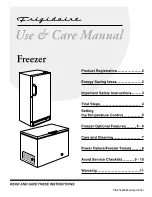
EN - 40 -
Temperature Warning:
The temperature display flashes “LF” and an audible warning sounds when the
temperature in the freezer is too high.
A rise in the temperature may be caused by;
• Frequent door opening for long periods of time
• Loading with large quantities of warm foods
• High ambient temperature
• An error with the appliances.
Check Warnings;
Warning codes are displayed in the freezer indicators if an incorrect temperature is detected
in the freezer or when a problem occurs in the appliance.
Also a warning sound is heard.
The problem code and audible alarm will continue until you press the SET or MODE
button. W hen you press one of these buttons, the audible alarm will stop immediately and
the “LF” warning will disappear in 15 minutes. You don’t have to call your service. This
condition may occur due to the reasons given above. You can keep storing your foods in
your freezer. If the “LF” warning does not disappear an hour after pressing the button, call
your service and do not re-freeze any thawed food. Thawed food must be eaten quickly
If your freezer is operating too loudly:
Normal Noises
Cracking (Ice cracking) Noise:
• During automatic defrosting.
• When the appliance is cooled or warmed (due to expansion of appliance material).
Short cracking
• Heard when the thermostat switches the compressor on/off.
Compressor noise
• Normal motor noise. This noise means that the compressor is operating normally.
The compressor may cause more noise for a short time when it is first activated.
Bubbling noise and splash:
• This noise is caused by the flow of the refrigerant in the tubes of the system.
Water flow noise:
• Normal flow noise of water flowing to the evaporation container during defrosting.
This noise can be heard during defrosting.
Air Blow Noise:
• Normal fan noise. This noise can be heard in No-Frost freezer during normal operation
of the system due to the circulation of air.
If the edges of freezer cabinet that the door joint contact are warm;
• Especially in summer (hot weather), the surfaces that the joint contact may get
warmer during the operation of the compressor, this is normal.
















































